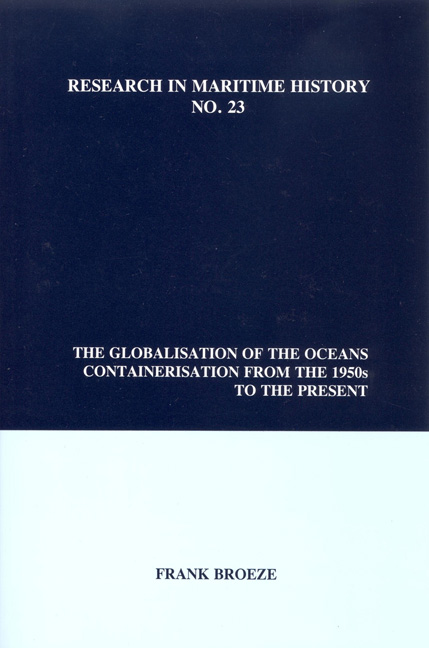Book contents
- Frontmatter
- Table of Contents
- List of Figures
- List of Tables
- Abbreviations
- Acknowledgments
- Preface
- Introduction
- Chapter 1 A Concept and its Realisation
- Chapter 2 The First Revolution
- Chapter 3 The 1970s: Conquering the World
- Chapter 4 The 1980s: Crisis and the Second Revolution
- Chapter 5 The 1990s: Globalisation
- Chapter 6 Ports, Port Systems and Liner Networks
- Chapter 7 Maritime Labour
- Chapter 8 Culture, the Environment and Recycling
- Conclusion
- Select Bibliography
Chapter 1 - A Concept and its Realisation
- Frontmatter
- Table of Contents
- List of Figures
- List of Tables
- Abbreviations
- Acknowledgments
- Preface
- Introduction
- Chapter 1 A Concept and its Realisation
- Chapter 2 The First Revolution
- Chapter 3 The 1970s: Conquering the World
- Chapter 4 The 1980s: Crisis and the Second Revolution
- Chapter 5 The 1990s: Globalisation
- Chapter 6 Ports, Port Systems and Liner Networks
- Chapter 7 Maritime Labour
- Chapter 8 Culture, the Environment and Recycling
- Conclusion
- Select Bibliography
Summary
The aim of the container operation is to replace this [conventional cargo handling] system with a through transport service which handles cargo in uniform, relatively large, but manageable units which, by application of mechanisation, can be moved from door-to-door with the minimum of hardship.
Containerisation revolutionised liner shipping in all its physical, functional, organisational and human aspects. It industrialised the process of cargo handling and propelled the liner business into the modern worlds of computer and information technology. It was based on the application of two simple and related principles: the homogenisation of cargo into standardised units of a handy shape and volume in order to increase port productivity and reduce ship's time in port; and the use of such standardised units to create an effective multi-modal sea-andland system with door-to-door transport from producer to consumer.
In the conventional maritime technologies that served the modern world economy until the 1960s, the piece goods carried by liner shipping were packed in bags, crates, boxes, packages, etc., of all kinds, sizes and shapes. For each successive stage of their voyage these had to be handled, sorted and stowed individually. This applied particularly to the land/sea interface, as the loading and discharging of the multitude of different cargo items between ship and wharf remained a slow and labourious process, even if since World War II some productivity gains had been made through the use of forklift trucks and pallets. Cargo-liners, on average, often had to spend a week or more in each port on their round-trip voyages, during which time not only they but also their cargoes were immobilised. By 1960 often not even fifty percent of ship time was spent at sea, and current technology had reached the limits of its capabilities to achieve improvements in efficiency and productivity. By contrast, in the relatively young bulk sectors of the maritime freight market, ever larger oil tankers and dry-bulk carriers, operating in synergy with dedicated modern cargo loading and discharging facilities ashore, indicated the way ahead towards greater productivity through specialisation and enlargement of scale. In other words, while maritime bulk transport had been industrialised, the liner sector had progressed little further than its early twentieth-century semi-artisanal stage.
- Type
- Chapter
- Information
- The Globalisation of the OceansContainerisation from the 1950s to the Present, pp. 9 - 26Publisher: Liverpool University PressPrint publication year: 2000



